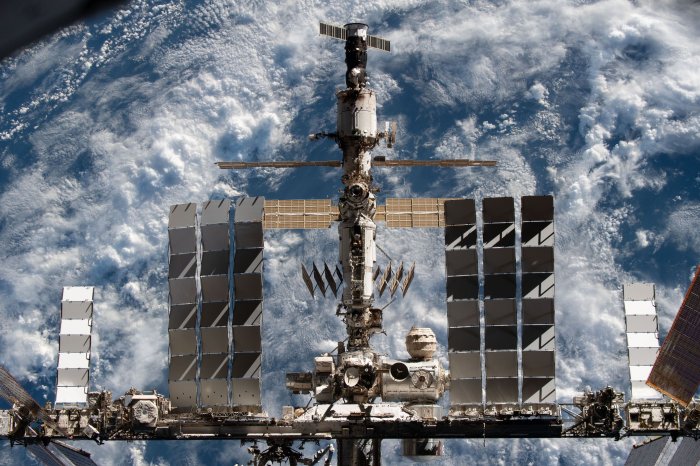1 of 3 | The James Webb Space Telescope was fully assembled for the first time in 2019 and is scheduled to be launched October 31. Photo courtesy of Northrop Grumman
ORLANDO, Fla., May 18 (UPI) -- The most powerful telescope ever built, the James Webb Space Telescope, is fully booked to peer at other planets and the origins of the universe for more than a year after its planned launch in October.
About 400 studies that could reveal secrets about the oldest galaxies, inhabitable planets and even the dawn of the universe are scheduled, scientists said.
"It's a totally different beast," said Nestor Espinoza, an astronomer who will be working on James Webb projects to examine planets outside our system. "We're going to see stuff that we were not expecting, and that is what really has me super excited."
The Webb telescope, named for NASA's second administrator, James E. Webb, is years behind schedule and billions of dollars over budget, with the cost approaching $10 billion.
NASA aims to finally launch it Oct. 31 aboard a European Ariane 5 rocket made by France-based Arianespace from Europe's Guiana Space Center in French Guiana, a region of France in South America. This is the European Space Agency's contribution to the international project, which also involved the Canadian Space Agency.
The Webb observatory will be much larger than its predecessor, the Hubble Space Telescope, which was launched in 1990. Webb's main mirror, or light-gathering surface, is 21 feet across, compared to Hubble's at 7.8 feet.
Webb's solar shield, which will keep its infrared instruments cold in space, is about the size of a tennis court. The telescope will orbit the sun, almost 1 million miles from Earth.
Webb will look billions of light years into the universe's history, according to NASA. Its more powerful infrared instruments are designed to see more clearly and a few hundred million light years farther than Hubble.
Hubble's most distant observation was the galaxy GN-z11, about 32 billion light years away, but the image was faint.
Augmenting Hubble
The new telescope will augment science performed by Hubble, not necessarily replace it, Espinoza said. He is part of the James Webb team at the organization that manages science done with such space instruments, a Baltimore-based a non-profit consortium of scientists that advises NASA.
Espinoza will serve as the principal scientist on projects in which the Webb telescope will examine two planets in distant planetary systems. One of them, K2-141b, is about 50 percent larger than Earth, while the other, WASP-63b, is a gas giant similar to Jupiter.
"Hubble can't perform the kinds of observations we need to learn about the atmospheres of these planets, or other details, since it was designed before the first planets outside our solar system were detected," Espinoza said.
Many of the proposed tasks for the Webb telescope were planned and approved in the 1990s as the observatory was under initial development, said Klaus Pontoppidan, an astronomer and Webb project scientist at the institute.
"We've just added the final projects that will be included during the first year or 13 months," Pontoppidan said.
The institute, which solicits proposals each year for Hubble, will do so for Webb, as well, and each of the space telescopes attract more than 1,000 such ideas each year, he said.
The Webb telescope will take about three months to power up, extend its massive mirror and begin observations. After that, scientists based at institutions around the world have planned more than 10,000 hours of observations with it.
Hundreds of hours
It takes an average of 25 hours to observe a single planet, but longer observations -- such as detecting the oldest and farthest galaxies -- will require about 200 to 300 hours, Pontoppidan said.
"The first galaxies in the universe, those are really faint objects, so you have to stare at them for a long time," he said.
Another big astronomy question for the telescope is to determine which came first -- galaxies or the black holes that reside at the heart of most large galaxies, said Rogier Windhorst, an astronomer and physics professor at Arizona State University.
While he's been waiting for the launch of Webb, Windhorst and his colleagues have conducted simulations that attempt to envision what the telescope can achieve, but those simulations cannot fully anticipate such discoveries, he said.
"It's going to be like Galileo first looking at the sky on a telescope, you know, discovering the moons around Jupiter in the rings of Saturn," Windhorst said. "Our eyes are going to be reopened to the universe. ... So, we're going to see new and unexpected things that we've never dreamed of."
Thousands on project
Thousands of people have worked on building the Webb telescope at NASA contractor Northrop Grumman's facility in Redondo Beach, Calif., said Bill Ochs, project manager for the space agency.
That number is starting to dwindle, he said, as NASA just completed the final test of the mirror unfolding devices last week. The spacecraft must fold for launch because it is too large to fit inside any existing rocket's nose cone.
"The astronomy community at large has developed the goals for James Webb over the years, especially the goal to understand the formations of the first galaxies and planets," Ochs said.
"Looking at other Earth-like planets is something that came about later in its development, and I think that science will be exciting -- especially if we find an atmosphere that could support life."
The International Space Station is pictured from the SpaceX Crew Dragon Endeavour during a flyaround of the orbiting lab that took place following its undocking from the Harmony module’s space-facing port on November 8. Photo courtesy of NASA
















